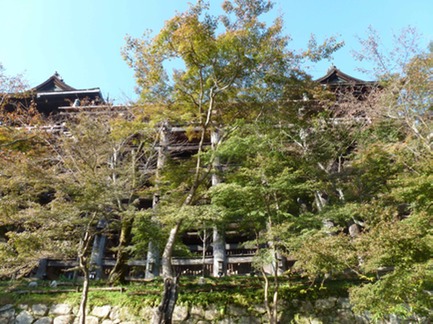
Although Kiyomizu-dera dates back to the early Heian period (794 to 1185) when the capital moved to Kyoto the present structures were built in 1633, on the orders of Tokugawa Iemitsu and were constructed without the use of nails. Given the size of the Main Hall (Hondo) and its veranda that opens off it, that's a rather impressive achievement. The veranda, supported by 13 metre high pillars, juts out above a precipice, offering impressive views across the city, and a spectacular view of cherry and maple trees towards the hills in spring and autumn.
Similar structures were apparently erected at a number of sites visited by large numbers of pilgrims during the Edo period. According to a tradition dating back to that era, jump off the verandah and survive the fall and your wish will be granted. That's the origin of the Japanese equivalent of taking the plunge, to jump off the stage at Kiyomizu. Two hundred and thirty-four people are supposed to have tried it during the Edo period, and, allegedly, 85.4% survived.
I did the maths to figure out an actual number, and came up with a figure of 199.836, which probably shows how rounding off affects your calculations. Multiplying by 85.5 comes to a tad over 200. In any case you're not allowed to do that any more.

The temple precinct contains fifteen buildings classified as Important Cultural Properties, including the inner Temple (Okunoin) a smaller scale version of the Hondo, Amida Buddha Hall (Amidado), and a vermilion three-tiered pagoda and several other shrines including Jishu - jinja, dedicated to Ōkuninushi, god of love and good matches. Visitors who succeed in walking between a pair of love stones with their eyes closed are supposedly guaranteed to find love, or their perfect match. Attempt to do so with assistance and you'll still find it, but will need the assistance of a go-between or matchmaker. There are also halls dedicated to the historical Buddha and another that contains close to two hundred statues of Jizo, protector of children and travellers. A visit to a structure at the southern end of the temple grounds is said to bring about easy and safe childbirth. Like most of its peers, the complex has an assortment of talismans, incense, and omikuji (paper fortunes) for sale, and when I spotted one that's supposed to protect travellers on the road I thought of the inimitable Staggster, and bought one.
We'd seen our share of temples and religious sites over the preceding two and a bit weeks, and there's a fair possibility that I was more or less templed out, but I must admit Kiyomizu struck me as a bit of a disappointment. There's no denying there's a great view back across the city, and the verandah, with its sheer drop is impressive when you're up there, and very impressive when you're standing on the bottom looking up, but the crowds were getting to me and a fair part of the complex was closed and undergoing repairs.